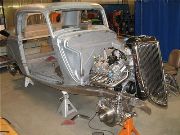This car just went straight to the top of the list of stuff we need to see upon our arrival at the 2009 SEMA show. It is a steel 1934 Ford packing a 400hp, 3.5 liter, Ecoboost V6. The car is a joint venture between Ford, Detroit Street Rods, and Experi-metal. We’d love to take this one for a spln!
The goal is to obviously show that just as much fun on the road cane come from a turbo V6 as opposed to a larger V8. It seems that the only major work done to the motor was a repackage of the turbos as they stuck way out when new.
Here’s the whole press release from Ford:
Hot rodders have always lived by the motto “There’s no replacement for
displacement,” indicating that the more cubic inches an engine has, the better
the resulting performance. Ford Powertrain and Detroit Street Rods are out to
prove that thinking out-of-date with their EcoBoost(TM)-powered ’34 Ford hot
rod.
To be introduced at this year’s Specialty Equipment Market Association (SEMA)
show, the Ford hot rod will be the “first” rear-wheel-drive application of the
3.5-liter twin-turbo EcoBoost V-6 delivering an estimated 400 horsepower and
400 ft.-lb. of torque – power numbers that easily rival a typical hot rod’s
302-cubic-inch V-8 or even a modern-day V-8 of similar size.
“EcoBoost technology shows that there is a viable replacement for
displacement,” said Dan Kapp, director of Ford Powertrain Research and
Advanced Engineering, who will be part of a SEMA “Driving Green” technology
briefing panel discussion during the show. “As consumers’ demand for fuel
efficiency continues to grow, and our commitment to delivering best-in-class
fuel economy remains steadfast, it’s important to show that performance does
not need to suffer as a result.”
“Hot rod builds provide blank canvases for SEMA member companies and SEMA is
uniquely positioned to demonstrate that horsepower and green power can coexist
without sacrificing performance or the cool factor,” said John Waraniak, SEMA
vice president of Vehicle Technology. “This ’34 EcoBoost hot rod is a
fantastic example of modern green technology being applied in a manner that
any performance enthusiast would love.”
The EcoBoost family of engines uses turbocharging and direct injection
technology to deliver up to 20 percent better fuel economy and up to 15
percent fewer CO2 emissions versus larger-displacement engines.
“The beauty of EcoBoost is that it enables us to downsize for fuel efficiency,
yet boost for power,” said Kapp. “We’re able to decrease the size of the
available engine – such as installing a V-6 versus a V-8 – yet boost the power
using turbocharging to deliver similar power and torque to that larger
engine.”
The first EcoBoost engine, a 3.5-liter twin-turbo V-6, launched this year on
the 2010 Ford Taurus SHO and Flex and on the Lincoln MKS and Lincoln MKT. The
EcoBoost V-6 produces 355 horsepower (365 hp in the Taurus SHO) and 350
ft.-lb. of torque.
Ford has recently announced the first four-cylinder EcoBoost engines,
launching in global applications beginning next year. The 1.6-liter EcoBoost
I-4 first arrives in Europe, followed by the 2.0-liter EcoBoost I-4 launching
on products in both Europe and North America.
Going forward, Ford will shift its powertrain strategy to be built around
EcoBoost technology. Under the new system:
— A 3.5-liter EcoBoost V-6 would replace naturally aspirated V-8 engines
— A 2.0-liter EcoBoost I-4 would replace naturally aspirated V-6 engines
— A 1.6-liter EcoBoost I-4 would replace naturally aspirated large I-4
engines
Following the launches of the new EcoBoost I-4s will be the extension of the
3.5-liter V-6 to the first rear-wheel-drive configuration in the F-150 pickup
truck late next year. Another global application, the Ford Falcon sedan in
Australia, will receive a rear-wheel-drive version of the 2.0-liter EcoBoost
I-4 in 2011.
The fun-to-drive nature of EcoBoost engines is leading Ford to introduce these
fuel-saving powertrains in large volumes virtually across its lineup. For
example, by 2013 more than 90 percent of Ford’s North American lineup will be
available with EcoBoost technology, and nearly 80 percent of Ford’s global
nameplates will have an available EcoBoost option.
By 2013, global EcoBoost volume throughout the Ford, Lincoln and Mercury
vehicle family is expected to be 1.3 million units, with up to 750,000 sales
coming from North America alone.
’34 Ford EcoBoost hot rod project
Detroit Street Rods’ latest build is a 1934 Ford and is a joint venture with
Ford Motor Company and Experi-metal. In this ’34 application, the EcoBoost
engine is configured for rear-wheel drive and is coupled with a Tremec
five-speed manual transmission.
“The decision to use the EcoBoost engine for our powertrain on this project
was an easy one in that it gave us the opportunity to combine the iconic ’34
Ford sculpted body lines with the advanced technology of the EcoBoost
powerplant,” stated Robert Smith, president of Detroit Street Rods. “The
result is the perfect hot rod marriage of advanced technology for power and
legendary automobile design.”
While the stock Honeywell turbochargers that drive the EcoBoost engine are
used, they were repackaged to fit the engine bay of this all-steel replica
body. The engine configuration and turbocharger packaging was dynamometer
tested by Ford Powertrain for proper calibration of the engine electronic
control module (ECM). In addition to the all-stock engine, other components
including the fuel pump, ECM, fuel pump module, fuel pump processor and
drive-by-wire throttle were utilized in their original production
configuration.
The body is from Steve’s Auto Restoration and is the recently released 1934
Ford 3-Window coupe. The complete body and fenders are from brand-new tooling,
and are designed, stamped and manufactured by Experi-metal in Sterling
Heights, Mich. This “replica” ’34 features all-steel construction, full
fenders, running boards, electronic power windows, air conditioning and custom
bumpers.
The engine was repackaged and fitted with an engine plate adapter to mate with
an aluminum flywheel, performance clutch and a Tremec TKO five-speed
transmission. The turbochargers were repositioned to the front of the cylinder
heads and custom aluminum tubing was used to route the air from the custom air
cleaner through the air-to-air intercooler. The exhaust gases are routed from
the cylinder heads through coated headers, through the stock wastegates, and
pass through large custom exhaust cones located outside the engine bay and
just above the front fenders.
About Ford Motor Company
Ford Motor Company (NYSE: F), a global automotive industry leader based in
Dearborn, Mich., manufactures or distributes automobiles across six
continents. With about 201,000 employees and about 90 plants worldwide, the
company’s automotive brands include Ford, Lincoln, Mercury and Volvo. The
company provides financial services through Ford Motor Credit Company. For
more information regarding Ford’s products, please visit www.ford.com.






















